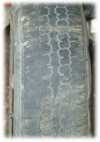Reading the road - All weather driving - Rain
Rain affects what you can see,what you can hear and your grip on the road.
What you can see
In wet weather your windows are more likely to mist up; avoid this by using the heater fan and air conditioning to keep air circulating.
Windscreen wipers can become overloaded in heavy rain, but leave smears on the screen in light rain; get to know the different windscreen wash and wipe settings for your car to help deal with this.
Other vehicles are harder to see in the rain; by using dipped headlights it will be easier for other drivers to see you.
What you can hear
Other traffic will be harder to hear. This is because of the noise from the rain and from your heater fan; you can make extra visual checks through the side windows and door mirrors to help compensate for this.
Your grip on the road
 There are no tyres available for racing drivers that will grip the road equally well in both wet and dry conditions but all modern road tyres will be more than adequate for your day-to-day driving needs. You can help your tyres (and yourself) by making sure that they comply with the legal tread depth requirements.
There are no tyres available for racing drivers that will grip the road equally well in both wet and dry conditions but all modern road tyres will be more than adequate for your day-to-day driving needs. You can help your tyres (and yourself) by making sure that they comply with the legal tread depth requirements.
The tread allows water to be displaced and lessen the chance of aquaplaning, which occurs when a car is driven at speed through heavy surface water; the tyres skim the surface of the water (like a water ski), leaving the driver with little steering and braking control.
Beware!
A light shower after a long dry spell in the summer can leave the road as slippery as ice. You will expect to come across ice in the winter – you are less likely to expect an ice-like surface in the summer!
Another, often unexpected danger is 'cross fall' on hills. This is usually found where the road goes around a bend and water takes the shortest route - straight across the road, effectively forming a shallow river.
Although this water might only be a couple of millimetres deep it can often cause severe loss of grip or aquaplaning. Worse still in winter when it can form ice sheets across the bend.
Next: Step 2 - Reading the road - All weather driving - Snow & ice...
